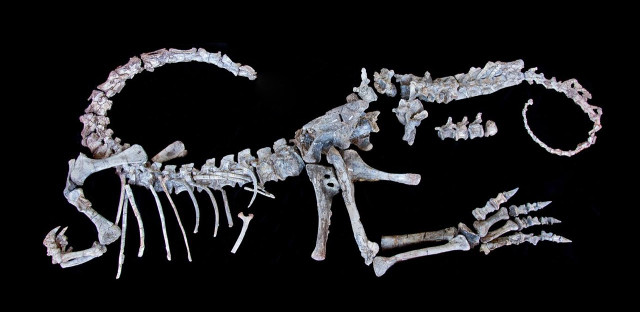
An article published in the journal “PLOS One” describes a research on Sarahsaurus aurifontanalis, a relatively small dinosaur but part of the clade of sauropodomorphs, the giant dinosaurs that include iconic species such as brontosaurus. Paleontologists Adam Marsh and Timothy Rowe of the University of Texas at Austin Jackson School of Geosciences studied the fossils of this dinosaur that lived about 185 million years ago analyzing migrations and diversifications within its clade.
Sarahsaurus aurifontanalis was discovered by Timothy Rowe along with a group of students in the Kayenta Formation in Arizona in 1997 and described in an article published in the journal “Proceedings of the Royal Society B” in October 2010. The paleontologist and his colleagues discussed the spread of dinosaurs and the fact that sauropodomorphs emigrated to today’s North America in separate waves after the extinction that occurred at the end of the Triassic period.
Two skeletons have been discovered, one almost complete and one partial, together with a poorly preserved skull of Sarahsaurus aurifontanalis. The skeletons, on the other hand, are well conserved in three dimensions and this allowed the creation of reconstructions following micro-CT scans, a version of the medical examination adapted to paleontologists needs.
The amount of information that can be obtained from almost complete skeletons and such a sophisticated examination is very useful to understand the characteristics of an organism and consequently to assess its kinships with other similar species. In the case of sauropodomorphs, doubts also concerned their spread between the Upper Triassic and the Lower Jurassic and the migrations towards today’s North America.
The sauropodomorph species discovered in North America and dating back to the lower Jurassic were Anchisaurus polyzelus and Seitaad ruessi so the first comparison of Sarahsaurus aurifontanalis was with them. According to Adam Marsh and Timothy Rowe these species are not closely related while they found greater similarities with other sauropodomorphs that lived in more distant areas.
The two researchers think that those species arrived independently in today’s North America. This occurred only in the lower Jurassic, so it’s possible that in the Upper Triassic there were geographical barriers or that these species found almost empty ecosystems after the end of the Triassic’s extinction. Dinosaurs became dominant only later, while in the Triassic period crocodiles were the dominating mainland vertebrates.
Interesting results also came from the examination of Sarahsaurus aurifontanalis’ physical characteristics. According to the researchers it most likely belongs to the family of massospondylids (Massospondylidae), which includes species found in almost the whole world. The examinations concerning this species’ anatomy will also be useful for another research in which Adam Marsh participates, whose purpose is to reconstruct the differences in various dinosaur species’ limbs to understand which ones led to their evolution and which are related to their age.
Both Sarahsaurus aurifontanalis skeletons show some characteristics in common in their femurs that have been considered very interesting. According to Adam Marsh those are very useful information to add to the research to reconstruct the evolution of sauropods that led to the emergence of the most massive species.


